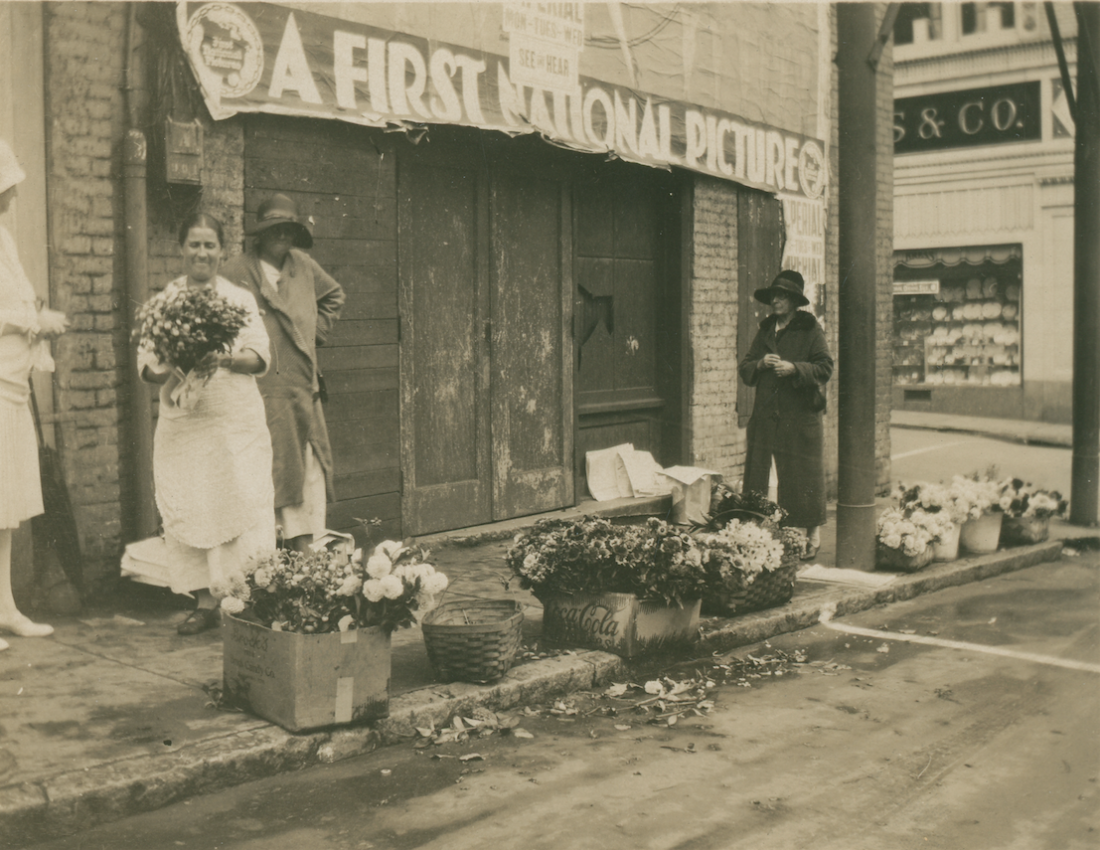In the autumn of 1920, residents were outraged when the city announced plans to start charging an annual $15 license fee (roughly $195 in today’s currency) to a group of vendors known collectively as the Flower Women. Over 200 people, “including many of the leading citizens,” signed a petition denouncing the plan, The Sunday Citizen reported on Sept. 19
“Oh, what a shame, to charge these poor old ladies for the privilege,” Andrew Mowbray wrote in a letter to the editor, published on Sept. 22. “[The Flower Women] should be paid by the city to let the tourists see what a lot of different varieties of beautiful flowers grow around Asheville.”
If the city needed money, Mowbray continued, “charge ten times as much for a license for these hideous, screeching, nerve-racking motorcycles, instead of charging these industrious women anything.”
Subsequent letters voiced similar disapproval. And like Mowbray, these writers offered alternative ways to raise municipal funds. One resident, Celia T. Shelmire, recommended the city fine “every individual expectorating on the sidewalks $5,” rather than compel the Flower Women “to seek other occupations on account of their inability to pay a tax.”
Despite the outcry, city commissioners approved the measure on Oct. 26, 1920. The license became the first of several new guidelines imposed on the Flower Women over the next decade.
By 1926, these sidewalk florists were ordered to leave their usual post on Haywood Street and Patton Avenue due to pedestrian congestion. According to a Dec. 13 article published in The Asheville Citizen, the Flower Women had convened at the intersection for over half a century.
“Loaded with galax leaves and holly wreaths, branches of mistletoe and other evergreen, the old women trundled in surprise up and down the streets,” the article stated. “Pallor and bewilderment showed from every line of their old and wrinkled faces, but the police were adamant and forced them to move on. Law was law, and orders were orders.”
In the same piece, the paper wrote, “It was as if the whole world had been suddenly removed from under them and they were left standing in space, shaken and uncertain what do expect next.”
The article concluded with a note that city commissioners intended to find a new stand for the Flower Women, “for even the city fathers admit that somehow, they, too, are loath with the general public to see the last landmark of Asheville’s quaint customs pass.”
Over the next few years, the Flower Women experienced a series of highs and lows as they set up shop on alternative streets in downtown Asheville. In October 1927, for example, Police Chief W.R. Messer accused the women of purchasing flowers for resale rather than gathering their selections from the wild. Mayor Gallatin Roberts warned the women against such practices, claiming it violated the law. Later, in the summer of 1929, The Asheville Citizen reported that a delegation of downtown business owners protested the women’s continued presence on the streets.
Finally, on Sept. 21, 1930, the Sunday edition of the Asheville Citizen-Times notified readers that city officials had dedicated new stands for the Flower Women at the intersection of Church Street and Patton Avenue, as well as on North Lexington (between College Street and Patton Avenue) and several other downtown thoroughfares. According to the article, weekly rotations would be enforced “to give all sellers opportunities to use the more desirable locations.”
In the same piece, the paper stated that the stands and the women who sold flowers from them were a reminder of “days when this city was a small mountain village.”
Editor’s note: Peculiarities of spelling and punctuation are preserved from the original documents.




In Chapel Hill they had a similar stink almost 50 years later when I was a grad student at UNC around 1970. The sidewalk flower vendors there were still universally called flower ladies as they had been for years instead of flower women. The Chapel Hill city government was definitely NOT a collection of “mean spirited republicans” even back then. But then a huge number of “hippie types” starting selling everything imaginable, from pot (marijuana) paraphernalia, to leather goods, to clothing, to organic food on the Franklin Street sidewalks and it was creating an obstacle to pedestrian traffic. The town council didn’t think they could legally ban the hippies but let the flower ladies stay. So they banned them all. And as in Asheville 50 years before, a great hue and cry in defense of the flower ladies arose. But it was to no avail, but the Town DID find a spot near Franklin street to which the ladies could relocate. https://blogs.lib.unc.edu/ncm/2012/04/20/the-flower-ladies-of-chapel-hill/
Thank you for reminding us of the Flower Ladies of Chapel Hill.